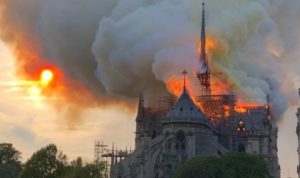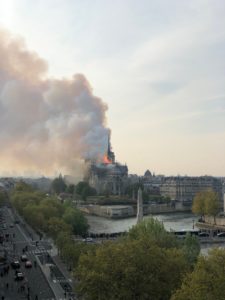Having grown up in the Parisian suburbs, the news concerning the burning down of Notre-Dame de Paris affected me deeply. Being a student of Heritage & Memory Studies, I’ve always had a great interest in anything of the past that has managed to survive into our unforgiving progress- and profit-driven era. However, it is not the thought of Medieval or Gothic relics being lost forever that saddened me. It is simply the fear that all the memories I had made near Notre-Dame might burn down with the physical structure of the Cathedral itself.
 The burning down of Notre-Dame (Alex Lantier, Creative Commons Attribution-NonCommercial 4.0 International License, 16/04/2019)
The burning down of Notre-Dame (Alex Lantier, Creative Commons Attribution-NonCommercial 4.0 International License, 16/04/2019)
Many of the debates in the heritage field surrounding the burning down of Notre-Dame tend to focus on issues of authenticity, ethics and morals. The question of how to restore a damaged or even entirely destroyed building is one that has been occupying the minds of architects for so many centuries and now heritage professionals, it is only natural that it should come up again in the event of such a dramatic loss for art-history. The article by Liselore Tissen entitled “The Threat After the Fire: the Restoration of Notre-Dame” is very useful in presenting “the binary in conservation” that still exists today. Before analysing the article more in-depth, it is worth noting that her article is published on the “Leiden Arts in Society Blog” public platform. Although it is a public platform implying that it is accessible to anyone regardless of their educational background, it is explicitly geared towards academics within Arts and Culture, thus providing an insight into current debates in academia and their perception of heritage.
Compared to academic publications on similar topics such as Robert Wickes’ “Architectural Restoration: resurrection or replication?” published in 1994, Tissen’s blog post takes the definition of certain key terms as a given due to the format of her writings. Indeed, whereas the definition of authenticity is the core of Wickes’ article, Tissen only suggests through her use of the word what she means by it. It seems that the “authentic structure”, “authentic information” and “authentic materials” she mentions, are all synonyms for the original or in other words how the Cathedral was just before the fire spread. This use of the word authenticity is closer to the everyday understanding of the word which, according to the Oxford English Dictionary is “of undisputed origin and not a copy; genuine”. Even though clear efforts were made by the author to make the debates about restoration more accessible than in a traditional academic paper, her piece nevertheless struck me as an example of how the study of heritage can sometimes leave out its most important actors: humans. In fact, as the conclusion of her blog post, the Arts & Culture researcher states that the collection of 3D scans of the Cathedral “gives us hope that l’esprit de Notre-Dame did not entirely go up in flames”. Just like Robert Wickes, Tissen seems to locate authenticity and spirit in the tangible structure and materials of buildings rather than in their relationship to human beings.
 Crowds observing the Notre-Dame fire (Greanville Post, Creative Commons Attribution-NonCommercial 4.0 International License, 23/04/2019)
Crowds observing the Notre-Dame fire (Greanville Post, Creative Commons Attribution-NonCommercial 4.0 International License, 23/04/2019)
Interestingly, it seems that less academically-oriented articles take this social dimension more into account, as their analysis of the debates surrounding the reconstruction of Notre-Dame are more closely related to issues of national identity and individual emotional connection. Although the article Steve Rose wrote for the Guardian is elitist in its own way – interpreting the damaged Cathedral ground as a playground for renowned architects, it is far more people-orientated than the sources mentioned above. For example, the architects’ short statements deal with questions such as “what is the expression of who we are now? Or who the French people are now? What does it represent? Who is it for?” which are so central to heritage. Indeed, if we understand heritage as contemporary uses or interpretations of the past which define present day identities, then this newspaper article would actually turn out to be most relevant and useful in understanding what is at stake in Paris at the moment. I am acutely aware that the articles I have chosen are not representative of the whole academic literature that is being written on the subject of architectural restoration. However, I hoped to show that while access to restricted sources and knowledge allows academics to go more in depth about certain topics, sometimes this privilege that researchers, including myself, have does not guarantee a better understanding of current issues in heritage.
Growing up in the suburbs of Paris and therefore having made many memories around Notre-Dame de Paris is what allows me to connect with and understand the current events rather than my “expertise” in heritage studies. The decisions that are currently being made concerning Notre-Dame’s restoration might change its appearance or art-historical value, but they will never change the emotional relationships that French citizens, or anyone else for that matter, develop when coming into contact with this unique space.
